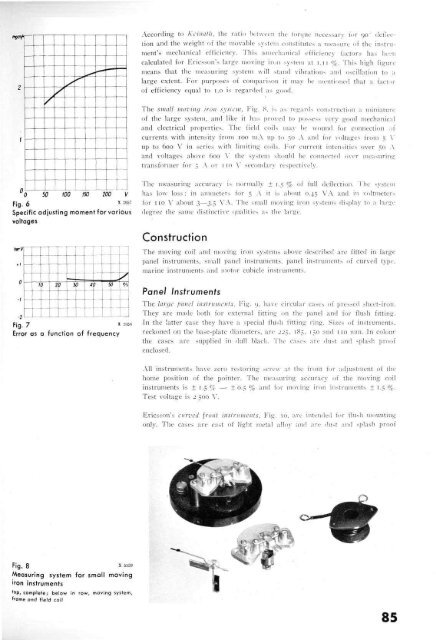ericsson review - History of Ericsson - History of Ericsson
ericsson review - History of Ericsson - History of Ericsson
ericsson review - History of Ericsson - History of Ericsson
You also want an ePaper? Increase the reach of your titles
YUMPU automatically turns print PDFs into web optimized ePapers that Google loves.
Fig. 7 * ' 95 «<br />
Error as a function <strong>of</strong> frequency<br />
Fig. 8<br />
x 5559<br />
Measuring system for small moving<br />
iron instruments<br />
top, complete; below in row, moving system,<br />
frame and field coil<br />
According; to Keinath, the ratio between the torque necessary for oo~ deflection<br />
and the weight <strong>of</strong> the movable system constitutes a measure <strong>of</strong> the instrument's<br />
mechanical efficiency. This ^mechanical efficiency factor* has been<br />
calculated for <strong>Ericsson</strong>'s large moving iron system at I.II %. This high figure<br />
means that the measuring system will stand vibrations and oscillation to a<br />
large extent. For purposes <strong>of</strong> comparison it may be mentioned that a factor<br />
<strong>of</strong> efficiency equal to i.o is regarded as good.<br />
The small moving iron system, Fig. X, i-, as regard-, construction a miniature<br />
<strong>of</strong> the large system, and like it has proved to possess very good mechanical<br />
and electrical properties. The field coils may be wound for connection <strong>of</strong><br />
currents with intensity from ioo niA up to 50 A and for voltages from 5 V<br />
up to 600 V in series with limiting coils. For current intensities over 50 A<br />
and voltages above 600 V the system should be connected over measuring<br />
transformer for 5 A or 110 V secondary respectively.<br />
The measuring accuracy is normally + 1.5 % <strong>of</strong> full deflection. The system<br />
has low loss: in ammeters for 5 A it is about 0.45 VA and in voltmeters<br />
for no V about 3—3.5 VA. The small moving iron systems display to a large<br />
degree the same distinctive qualities as the large.<br />
Construction<br />
The moving coil and moving iron systems above described are fitted in large<br />
panel instruments, small panel instruments, panel instruments <strong>of</strong> curved type,<br />
marine instruments and motor cubicle instruments.<br />
Panel Instruments<br />
The large panel instruments, Fig. 9, have circular cases <strong>of</strong> pressed sheet-iron.<br />
They are made both for external fitting on the panel and for flush fitting.<br />
In the latter case they have a special flush fitting ring. Sizes <strong>of</strong> instruments,<br />
reckoned on the base-plate diameters, arc 22^,. 185, 150 and no mm. In colour<br />
the cases are supplied in dull black. The cases are dust and splash pro<strong>of</strong><br />
enclosed.<br />
All instruments have zero restoring screw at the front for adjustment <strong>of</strong> the<br />
home position <strong>of</strong> the pointer. The measuring accuracy <strong>of</strong> the moving coil<br />
instruments is ± 1.5 % — ±0.5 %. and for moving iron instruments ± 1.5 %.<br />
Test voltage is 2 500 V.<br />
<strong>Ericsson</strong>'s curved front instruments, Fig. 10, are intended for flush mounting<br />
only. The cases are cast <strong>of</strong> light metal alloy and are dust :md splash pro<strong>of</strong><br />
85
















